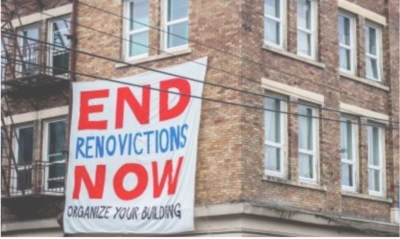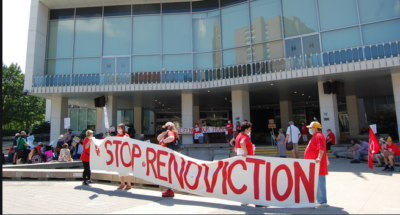 By Staff
By Staff
September 23rd, 2021
BURLINGTON, ON
Earlier this week Community Development Halton put out a very good report. It was lengthy – so we decided to break it down into several segments.
There is a nasty process that some landlords use to evict their tenants – make some upgrades to the property and then put it back on the market – at a significant rent increase.
The market for rental housing is very very tight.
The process is known as renovictions

Organizing and fighting back. Does it work?
There has been a drastic increase in the number of renovictions in the past few years. Landlords are allowed to end tenancy if major renovations are required to a tenant’s unit by issuing a N13 (notice of termination for renovation or repair).
Eviction notices like the N13 or N12 (terminating a tenancy for landlord’s own use), are not the same as an eviction order but a tactic used by landlords to regain control of the unit.
In Ontario, the only way to legally evict a tenant is through a hearing at the Landlord and Tenant Board. If after receiving the N13, a tenant decides if they want to challenge it. Their next step is an LTB hearing, in which an adjudicator listens to both sides, considers the evidence and then makes a decision.
The majority of these cases never reach the LTB and therefore this becomes an illegal eviction strategy that is used to increase rental costs.
It is becoming increasingly common for landlords to evict tenants and then re-list the same unit a couple of months later, with a few to no renovations completed at all. If the tenant decides to move out without going through the LTB process, they have the right to move back into their unit once the renovation is completed. The landlord cannot increase the rent – generally they can only raise it according to the percentage mandated by the province’s rent increase guideline.
According to a November 2019 report from the Advocacy Centre for Tenants Ontario, over the past four years in Toronto there has been a 294 per cent increase in N13 applications and an 84 per cent rise in N12 applications.
However, since landlords need a building permit to evict tenants, the city could use that as a leverage tool if they find out that the permit has been used fraudulently (the work was never done, or the tenant never got the right of first refusal).

The renoviction practice takes place in the area. – this was in Hamilton.
The landlord should then get another permit moving forward. Challenging an eviction notice is a lengthy process that requires a lot of maneuvering through a complicated system. And for a lot of tenants, the stress of a potential eviction is reason enough to start looking for a new home.
The current provincial government has placed a temporary ban on evictions during the pandemic and landlords are encouraged to work with tenants to establish fair arrangements to keep tenants in their homes, including deferring rent or other payment arrangements.
However, back pay in rent is piling up and many are still getting eviction notices which leads to an uncertain future for many when it comes to where they will live once the eviction bans are lifted.
Related news story:
Affordable housing – how can it be made to happen?



















